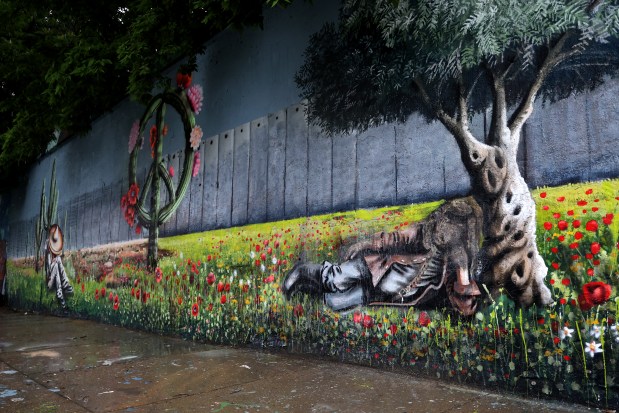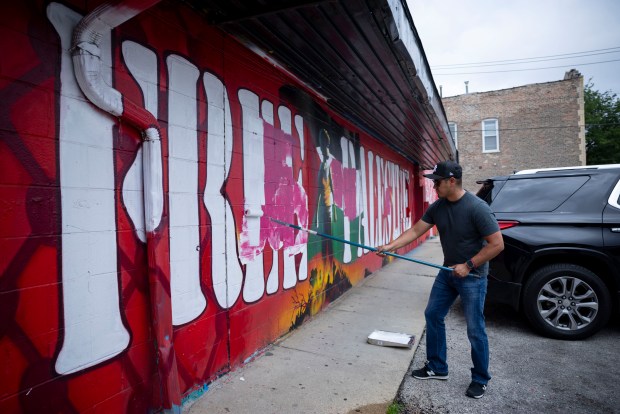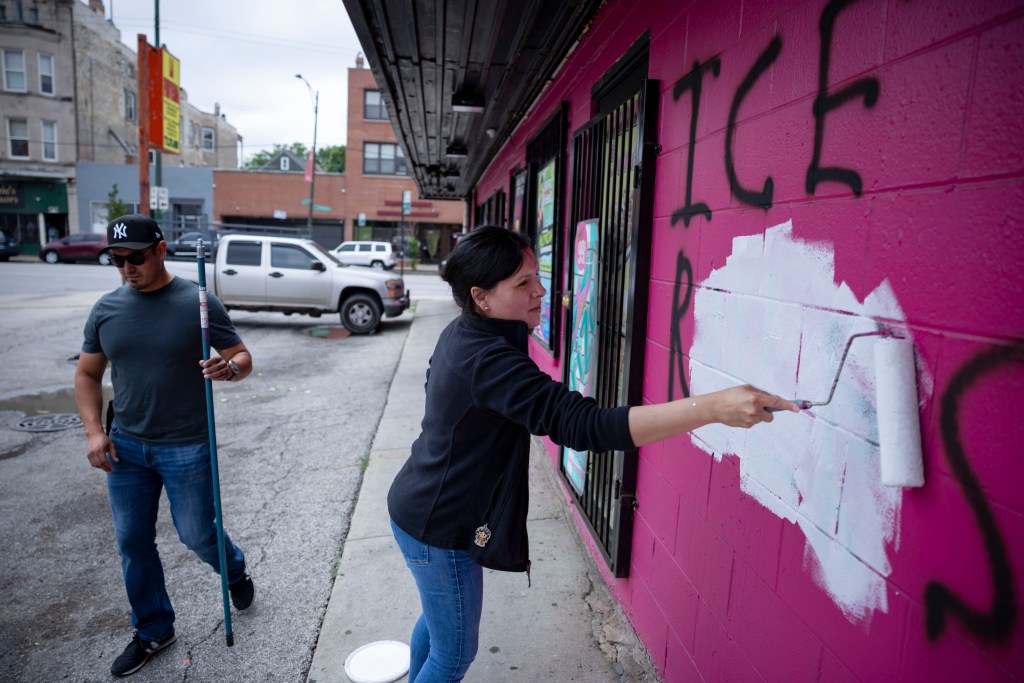Daniel Kirzane said he was cautious and curious after learning someone posted antisemitic graffiti across the street from his synagogue in Hyde Park. While the congregation contacted Chicago police just to be safe, Kirzane said he didn’t think it was a “real threat.”
Rather, Kirzane said he viewed it as “public intimidation” — the kind his congregation wouldn’t “give in to.”
“These aren’t the values we hold by in Hyde Park, which is a community that’s proud of its diversity,” said Kirzane, rabbi at KAM Isaiah Israel Congregation. “And I think many Jews are upset to be singled out in this negative way.”
Vandals tagged at least four locations in Hyde Park in June with antisemitic messages, police said. Murals depicting solidarity with Palestinians and immigrants were defaced that same month in Pilsen. Just weeks later, taggers drew hate symbols and language on buildings in Little Village. The rash of vandalism has shaken communities across Chicago, and while residents have mustered support for their affected neighbors, the vandalism reflects a concerning rise in hateful ideologies, experts and advocates said.
“To experience something like this is scary,” Chicago Human Relations Commissioner Nancy Andrade said. “It really rattles you, and what you think may have been a safe community makes you start to think again.”
While overall hate crimes in Chicago have decreased between 2023 and 2024, reported cases against Jewish people and gay men increased, according to a July 18 city news release. Antisemitic hate crimes increased 58% last year to account for about 38% of total hate crimes.
Still, it seems people are more willing to express their hate, said Loyola University Chicago professor Jeannine Bell, who studies policing and hate crime. She attributed that willingness in part to the rollback of diversity, equity and inclusion initiatives and civil rights enforcement at the federal level. Those policies create a national conversation that has “percolated down” to more local displays of hate and bias, she said.
To DePaul University professor Joseph Mello, President Donald Trump and his administration’s attacks on immigrant groups have contributed to what he described as a trickle-down effect.
“It creates a permission structure for average people to say some pretty vile stuff and do some pretty vile things,” said Mello, a political science professor who researches speech rights and law.
Throughout June, Pilsen was hit with hate-related defacements. At a mural depicting a Palestinian man by 16th Street and Ashland Avenue, a woman burned the face of the painted subject. The woman also threw trash and feces at the mural, according to Natalie Figueroa, who said the vandal assaulted her when she tried to intervene.
 A vandalized mural with a burned face of a Palestinian man, along 16th Street near Ashland Avenue in Chicago’s Pilsen neighborhood on June 18, 2025. (Antonio Perez/Chicago Tribune)
A vandalized mural with a burned face of a Palestinian man, along 16th Street near Ashland Avenue in Chicago’s Pilsen neighborhood on June 18, 2025. (Antonio Perez/Chicago Tribune)
Alyssa Hall, a technology consultant who has lived in Pilsen for six years, said the defacements have upset her.
“They’re kind of taking the heart of what this neighborhood is — resistance, building a community outside of your own and that solidarity — and attacking it,” she said.
As a result of recent hate-related vandalism in Pilsen, Hall is more wary of people from outside the neighborhood and their intentions, she added. She urged her community to stay vigilant and for visitors to remain respectful of the neighborhood.
One of the most significant impacts of hateful expressions, including the graffiti in Hyde Park and the mural defacement in Pilsen, is its chilling effect on the rest of a community, Mello said.
“Hate speech is … meant to intimidate and silence other people into not speaking,” Mello said. “It’s designed to make people speak less, to scare people.”
Mello pointed to last weekend’s vandalism in Little Village, where Latino-owned businesses and advocacy organizations discovered their buildings tagged with swastikas and pro-immigrant enforcement messages. He said those messages can make immigrants feel less safe about their communities.
 Owner Juan Ocampo paints over graffiti of swastikas on a “Free Palestine” mural by artist Milton Coronado on July 20, 2025, after an overnight vandal tagged their grocery store, La Fruteria, for the second night in a row in the 2700 block of West Cermak Avenue in the Little Village neighborhood of Chicago. (Brian Cassella/Chicago Tribune)
Owner Juan Ocampo paints over graffiti of swastikas on a “Free Palestine” mural by artist Milton Coronado on July 20, 2025, after an overnight vandal tagged their grocery store, La Fruteria, for the second night in a row in the 2700 block of West Cermak Avenue in the Little Village neighborhood of Chicago. (Brian Cassella/Chicago Tribune)
And even if the iconography isn’t familiar to the general public, hate-related vandalism can still damage a community, Mello added.
An individual defaced Hoste, a recently opened event space in Pilsen, with a Nazi symbol called the Black Sun in mid-June. Co-founder Jordan Tepper said when his staff saw the circular shapes spray painted on four exterior doors the morning of June 16, they had to look up what they represented. In the last few years, several far-right and neo-Nazi groups have adopted the symbol.
“What was really affected was the staff,” Tepper said. “It’s not good to feel unsafe in your place of work.”
Though police caught the vandal, they told Tepper it would be difficult to charge the incident as a hate crime, he said. Nonetheless, community members who reached out in support of Hoste told Tepper they felt “hurt and frustrated” by the graffiti, he said.
Jordan Esparza-Kelley, a spokesman for the Council on American Islamic Relations-Chicago, said the vandalism has made many Muslim, Arab and South Asian Chicagoans worried about the “viability” of living here.
“It does, for many in the community, beg the question of ‘Is it OK for us to exist here?’” he said. “‘Is it safe for us to exist here?’”
He added that authorities need to do more when hate affects communities of color, such as in Pilsen. Police did not make an arrest after the mural defacement, and the woman responsible walked away from the scene after officers arrived, advocates said during a June 18 news conference.
How officials respond to hate-related vandalism can make or break a community’s recovery, Bell said.
“This is not a victimless crime. … Words matter, damage matters,” Bell said. “It is incredibly traumatizing to … walk past a swastika or a slur on a building. When you catch the perpetrator, punish the perpetrator, that is recognition that this is something that is damaging not just to the property owner but to anyone who sees it.”
Based on her research, dedicated hate crime units in municipal law enforcement are the best positioned to accumulate expertise to fight hate incidents, she said. Chicago police established a human relations section in the 1940s to deal with “ethnic intimidation” cases. Over the decades, it’s evolved into the hate crimes team housed in the office of equity and engagement.
Aside from organization, the amount of effort put into solving hate crimes is also important, Bell said. The percent of hate crimes resulting in arrests and charges decreased from about 14% in 2021 to 5% in 2024, according to Chicago police data. Between 70% to 80% of cases were suspended in that time period, meaning all investigative avenues were exhausted but the case couldn’t proceed.
Chicago’s Human Relations Commission also provides victim support to property owners and individuals targeted by hate-related vandalism, Andrade said. After the antisemitic messages in Hyde Park the commission reached out to KAM Isaiah Israel, she said. Andrade’s staff also contacted local business owners and advocacy groups such as Latinos Progresando in Little Village after their buildings were tagged, she added.
The Human Relations Commission also focuses on educational outreach, Andrade said, launching campaigns to help residents understand when and how to report hate incidents.
“They’re speaking up, which is wonderful. That is awesome,” Andrade said. “Hyde Park communities spoke up. Little Village communities spoke up: ‘We don’t want this.’” They immediately alerted the authorities. We were alerted about this. We are very happy that (reporting) is happening.”
And based on the recently released data showing an increase in hate crimes against Jewish people, the Human Relations Commission plans to hold special hearings on antisemitism in September.
Just like government responses, how a community reacts to hateful vandalism can also affect how targeted groups recover, Bell said. If a majority of neighbors speak up to say a hate display doesn’t represent the neighborhood, it doesn’t have to “stain” the community, she said.
Kirzane said by and large, the Hyde Park community has moved on from late-June’s antisemitic taggings. In addition to encouraging responsiveness from police and the Human Relations Commission, Kirzane said the offices of two aldermen, local churches and neighbors also reached out to ask how they could help.
“If we didn’t have that, it would be harder to move on,” Kirzane said.
